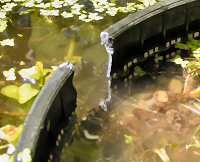It makes sense, given the way the climate is changing, to imagine how your garden will cope during drought whenever you are doing any design work or planting.
Wildlife gardens which use native species, which tend to be more resilient to drought, should suffer less than most during periods of dry weather. But the threat of global warming is
so severe that even
English Nature are now advising gardeners to use drought-resistant exotics, where appropriate, in order to safeguard the provision of nectar and pollen for our native invertebrates in the garden (see news item for
22nd May).
 Pond planting crate with tadpole-friendly modification.
Pond planting crate with tadpole-friendly modification.
Ponds can be problematic in dry weather too. It doesn't take a long time without rain before water levels in ponds start to fall. Regularly topping your pond up with tap water can lead to problems with algae like blanket weed because of nitrates in the water, so you must either top them up with water from rain butts, or find other ways to cope. So far I have managed my pond without topping up during dry weather. Last year when the level dropped by more than six inches I took special measures to
prevent the liner from being exposed to the sun.
With the recent dry weather, the pond water level is dropping again and I recently took the steps to help tadpoles which can find themselves stranded in planting crates when the water drops below the rim: I've cut small slots in the crate rims down to the level of the soil, ensuring that there is always a way out for the tadpoles.